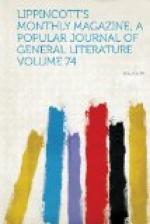the old man paused, and resting upon his staff, raised
his age-dimmed eyes, and pointing to the gushing water,
said,
’E questo si chiama il Tevere a Roma!’
(’And this is called the Tiber at Rome!’)
... We followed the stream from the spot where
it issued out of the beech-forest, over barren spurs
of the mountains crested with fringes of dark pine,
down to a lonely and desolate valley, shut in by dim
and misty blue peaks. Then we entered the portals
of a solemn wood, with gray trunks of trees everywhere
around us and impenetrable foliage above our heads,
the deep silence only broken by fitful songs of birds.
To this succeeded a blank district of barren shale
cleft into great gullies by many a wintry torrent.
Presently we found ourselves at an enormous height
above the river, on the ledge of a precipice which
shot down almost perpendicularly on one side to the
bed of the stream.... A little past this place
we came upon a very singular and picturesque spot.
It was an elevated rock shut within a deep dim gorge,
about which the river twisted, almost running round
it. Upon this rock were built a few gloomy-looking
houses and a quaint, old-world mill. It was reached
from the hither side by a widely-spanning one-arched
bridge. It was called Val Savignone."[1] Beyond
this, at a small village called Balsciano, the hills
begin to subside into gentler slopes, which gradually
merge in the plain at the little town of Pieve San
Stefano.
[Illustration: CAPRESE.]
Thus far the infant stream has no history: its
legends and chronicles do not begin so early.
But a few miles farther, on a tiny branch called the
Singerna, are the vestiges of what was once a place
of some importance—Caprese, where Michael
Angelo was born exactly four hundred years ago.
His father was for a twelvemonth governor of this
place and Chiusi, five miles off (not Lars Porsenna’s
Clusium, which is to the south, but Clusium Novum),
and brought his wife with him to inhabit the palazzo
communale. During his regency the painter
of the “Last Judgment,” the sculptor of
“Night and Morning,” the architect of
St. Peter’s cupola, first saw the light.
Here the history of the Tiber begins—here
men first mingled blood with its unsullied waves.
On another little tributary is Anghiara, where in
1440 a terrible battle was fought between the Milanese
troops, under command of the gallant free-lance Piccinino,
and the Floren-tines, led by Giovanni Paolo (commonly
called Giampaolo) Orsini; and a little farther, on
the main stream, Citta di Castello recalls the story
of a long siege which it valiantly sustained against
Braccio da Montone, surnamed Fortebraccio (Strongarm),
another renowned soldier of fortune of the fifteenth
century.
[Footnote 1: The Pilgrimage of the Tiber,
by Wm. Davies.]
[Illustration: LAKE THRASIMENE.]




